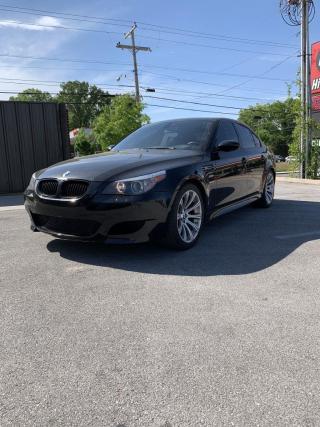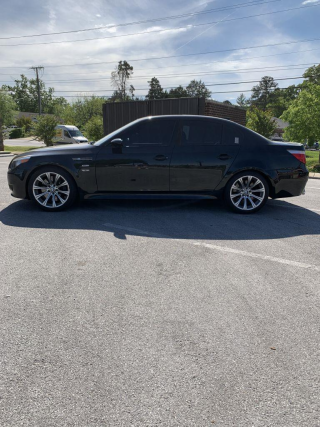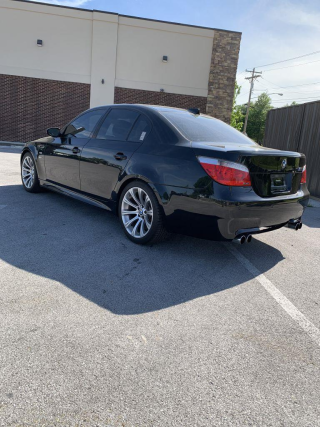The Good
The 2007 BMW M5 offers immense advantages: a thrilling 500hp V10 engine provides supercar-level performance and an intoxicating soundtrack, appealing directly to emotional buyers. Its luxurious cabin and four-door practicality make it a surprisingly comfortable and usable daily driver. The understated yet aggressive design, coupled with high-quality materials, represents excellent value in the used market for such a high-performance executive sedan.
The Bad
The 2007 BMW M5 demands vigilance. Its complex SMG III transmission is notorious for costly hydraulic pump failures and clutch wear. Critically, rod bearing issues are a significant concern, requiring proactive attention to prevent catastrophic engine damage. Owners should also anticipate high fuel consumption, frequent maintenance, and expensive repairs for various electronic components and throttle actuators.
2007 BMW M5: Quick Overview
- Engine: S85B50 naturally aspirated 5.0-liter V10
- Horsepower: 500 hp (373 kW) at 7,750 rpm
- Torque: 383 lb-ft (519 Nm) at 6,100 rpm
- Fuel Economy (EPA est.): 11 MPG city / 17 MPG highway / 13 MPG combined (requires premium fuel)
- 0-60 MPH: Approximately 4.1 - 4.5 seconds
- Towing Capacity: Not rated or recommended
- Key Trim-Level Features (M5 was a singular, highly-equipped trim):
- Performance:
- 7-speed SMG III (Sequential Manual Gearbox) with Drivelogic (11 shift programs)
- M Dynamic Mode (MDM) with variable traction control settings
- M-tuned suspension with electronic damper control (Sport, Normal, Comfort modes)
- M Servotronic speed-sensitive steering
- High-performance braking system (ventilated, cross-drilled discs)
- 19-inch M light alloy wheels with performance tires
- M-specific differential
- Interior & Technology:
- Full Merino leather upholstery
- Power-adjustable M Sport seats (heated front)
- iDrive infotainment system with DVD-based navigation
- Logic7 premium audio system
- Dual-zone automatic climate control
- Head-Up Display (HUD)
- Park Distance Control (PDC) front and rear
- Bi-xenon adaptive headlights
- Power moonroof
- Optional Features:
- Comfort Access keyless entry
- Heated rear seats
- Power rear sunshade and manual side rear sunshades
- Active backrest width adjustment for front seats
- BMW Assist telematics system
- Performance:
2007 BMW M5 Specifications
Vehicle Information
| Year | 2007 |
| Make | BMW |
| Model | M5 |
| Trim | - |
| Style | Sedan 7-Speed Manual |
| Type | Sedan |
| Category | Mid-Size Car |
Manufacturing Details
| Made In | Germany |
| Manufacturing City | GREER |
Dimensions
| Doors | 4-Door |
| Curb Weight | 4012 pounds |
| Gross Vehicle Weight Rating | 5071 pounds |
| Overall Height | 57.80 inches |
| Overall Length | 191.50 inches |
| Overall Width | 72.70 inches |
| Wheelbase Length | 113.70 inches |
| Standard Seating | 5 |
Engine & Performance
| Engine | 5.0-L V10 DOHC 40V |
| Engine Size | 5L |
| Engine Cylinders | 10 |
| Transmission | 7-Speed Manual |
| Transmission Type | Manual |
| Transmission Speeds | 7-Speed |
| Drivetrain | Rear-Wheel Drive |
Additional Features
| Anti-Brake System | 4-Wheel ABS |
| Steering Type | Rack & Pinion |
Pricing
| Manufacturer Suggested Retail Price (MSRP) | $82,500 |
| Invoice Price | $75,900 |
| Delivery Charges | $695 |
Vehicle History Report
Specifications
History
Events
History Check
Check
Check
Check
Check
Listings
Recalls
Check
Analysis
What Problems Does the 2007 BMW M5 Have?
The most prominent is the SMG III Transmission. Its hydraulic pump (commonly referred to as the SMG pump) is prone to failure, often requiring expensive replacement and leaving the vehicle undrivable. Clutch wear is also accelerated, especially with aggressive driving or extensive city use, leading to frequent and costly clutch changes. Various position sensors and actuators within the SMG system can also fail, causing shifting issues.
Another critical concern is the Rod Bearings in the S85 V10 engine. The original bearings are known to wear prematurely, potentially leading to catastrophic engine failure if not proactively replaced with upgraded aftermarket units. This issue affects all S85 V10 engines across its production run, including the 2007 model year. It's a top priority for any potential owner.
Throttle Actuators are also a common failure point. The M5 utilizes two of these, and their internal gears or electronics can fail, resulting in reduced engine power and activating "limp mode."
The VANOS System, while robust, can develop issues over time, such as failing high-pressure lines, solenoids, or the VANOS pump itself, leading to rough idle or decreased performance.
General electrical gremlins, common in complex luxury cars, can manifest as iDrive malfunctions, sensor failures (e.g., parking sensors), or wiring harness problems.
In terms of Recalls, the 2007 M5 (E60 chassis) was subject to a recall concerning a potentially faulty battery cable connection in the trunk, which could lead to power loss or fire risk. Additionally, some models were affected by the broader Takata airbag inflator recall. Prospective buyers should always check a specific vehicle's VIN for any open recalls.
How long will the 2007 BMW M5 last?
What Technology & Safety Features are Included?
Built-in Tech & Entertainment: The core of its technology was the iDrive infotainment system (CCC generation), which controlled navigation, climate, audio, and vehicle settings via a central controller and a large dashboard display. While innovative, it was often criticized for its complexity compared to modern systems. Standard features included a DVD-based navigation system, a premium Logic7 audio system with excellent sound reproduction, and BMW's pioneering Head-Up Display (HUD), which projected speed, navigation cues, and gear selection onto the windshield. Bluetooth connectivity for hands-free phone calls was typically an option, or required specific modules. An auxiliary input was usually present for external audio devices.
Driver-Assistance Features: The M5 included Park Distance Control (PDC) with front and rear sensors to aid parking. Standard cruise control was present. For dynamic control, the sophisticated Dynamic Stability Control (DSC) system with an "M Dynamic Mode" (MDM) offered varying levels of electronic intervention, allowing for more spirited driving with a safety net.
Safety Features: A comprehensive suite of safety features was standard, including multiple airbags (front, side-impact, and head airbags for front and rear occupants), active front headrests to mitigate whiplash, and a high-performance M-specific braking system. The Bi-Xenon Adaptive Headlights, which swiveled to illuminate around corners, significantly enhanced nighttime visibility.
Crash-Test Ratings: The 2007 BMW M5, being a niche high-performance variant, was not directly crash-tested by major U.S. organizations like NHTSA or IIHS. However, the underlying E60 5-Series chassis, upon which the M5 is based, received a 5-star rating for adult occupant protection from Euro NCAP in 2004, suggesting a high level of passive safety. It's reasonable to assume the M5 would offer similar, if not enhanced, structural integrity.
What Colors Options are Available?
2007 BMW M5 Prices and Market Value
Currently, used market prices for a 2007 M5 vary drastically. Expect to find examples ranging from $15,000 for high-mileage cars needing substantial work, up to $30,000-$40,000+ for well-maintained, lower-mileage vehicles with documented service history, especially if critical issues like rod bearings and SMG pump have been addressed. Exceptionally clean, low-mileage, fully sorted cars can fetch even higher prices.
Factors significantly affecting resale value include a comprehensive, verifiable maintenance history (crucial for rod bearings and SMG components), overall mechanical and cosmetic condition, and mileage. Any deferred maintenance or existing mechanical issues will severely impact its value.
2007 BMW M5 Cost of Ownership
2007 BMW M5 Fuel Efficiency
2007 BMW M5 Safety Rating
NHTSA
IIHS
2007 BMW M5 Warranty
Basic
Powertrain
Rust
2007 BMW M5 Insurance
reasonable repair costs.
How Does the 2007 BMW M5 Compare to Other Sedan?
Performance: The M5, with its high-revving 5.0L V10 (500hp) and 7-speed SMG III, offered a raw, track-focused experience with razor-sharp handling and a glorious exhaust note. The E63 AMG featured a more torquey 6.2L naturally aspirated V8 (507hp) paired with a traditional 7G-Tronic automatic, delivering immense straight-line thrust with a more luxurious, less frenetic feel. The Audi S6, also sporting a detuned 5.2L V10 (435hp) and standard Quattro AWD, provided strong performance and all-weather capability, but was generally perceived as less agile and engaging than the M5.
Features: All three offered a wealth of luxury and technology for their time. The M5's iDrive was pioneering, though often complex. The E63 AMG provided a plush, elegant interior. Audi's MMI was a strong competitor. The M5 often felt more driver-centric in its cabin design.
Reliability: This is a common pain point across all high-performance German sedans of this era. The M5 is infamous for SMG pump failures, rod bearing wear, and throttle actuator issues, leading to very high repair bills. The E63 AMG's M156 V8 engine is known for head bolt failures (pre-2011), camshaft/lifter wear, and excessive oil consumption, which are equally expensive to address. The Audi S6 V10 faced issues like carbon buildup and ignition coil failures, though arguably less catastrophic than the M5's rod bearings or AMG's head bolts.
Price (Used): Used M5s and E63 AMGs often occupy similar price brackets, largely dependent on maintenance history and condition. The S6 V10 typically sits a bit lower in price. All have depreciated significantly, offering immense performance for relatively low acquisition costs, but high ownership costs.
Alternatives/Recommendations: For unadulterated driving engagement and that iconic V10 sound, the M5 is hard to beat, especially if a rare manual conversion is found. For a blend of brute force and luxury with a more conventional automatic, the E63 AMG is a strong contender, but research its specific engine issues. If all-wheel drive and a more understated, refined V10 experience are priorities, the Audi S6 is a good choice. For those willing to sacrifice sedan practicality for a pure sports car thrill at a similar performance level, a 2007-2008 Porsche 911 (997) Carrera S is an excellent alternative.



